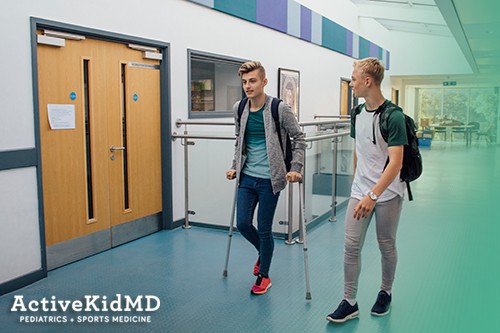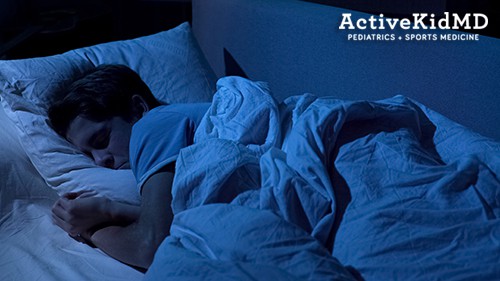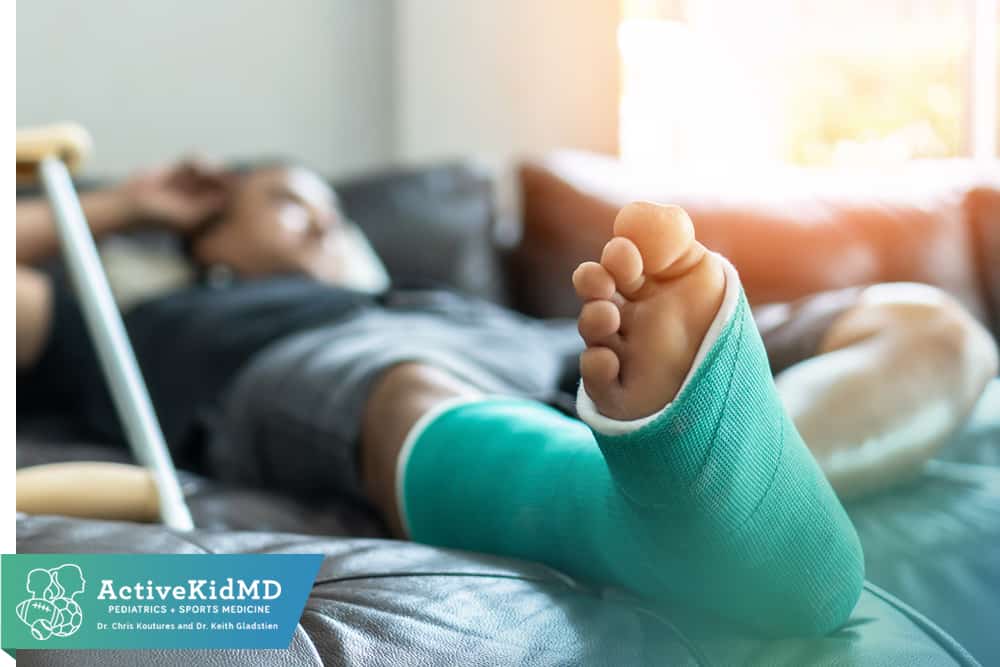You’ve just crashed and burned with a major injury. You realize this will keep you out of action for a long time or even need surgery. At this very moment, thinking about school, sleep, food and mood aren’t probably high on your list of immediate concerns. In working with school-age through Olympic athletes with serious injuries, I have found proactively addressing those details can have a big-time positive effect on recovery. That’s why I think this blog is important and want to share it with you, your family, and your rehabilitation team.
All injuries suck to some degree, but when you land awkwardly and immediately have that wonderful burst of pain or when your medical provider has that look on their face and hands you a box of tissue before explaining your MRI report, you know you are really messed up.
So when you are sitting on the court or in those exam rooms, would it help to know some key things that might ease some of the difficulty and discomfort of the recovery process?
Thought so.
Back in medical school, we were taught the concepts of the “pre-operative physical.” The goal was to best prepare the patient for surgery which often included reviewing medications, looking for any illnesses that could affect surgery or anesthesia, and getting important lab work.
While those are all necessary goals, I have found that there usually wasn’t much emphasis placed on the “post-operative” phase, and in the spirit of this blog, we’ll add in the “post-injury” phase as well.
I have started to spend more time with my type of “pre-op” (or can even be immediate “post-op”) or “post-injury” evaluations and have found that athletes and families really connect with the tips. Now, most of the credit must go to past patients who mentioned many a “wish I would have known” moment. For this, I am thankful and ready to share ways to best heal and deal with major injuries.
I’ll start with one pearl that I learned the hard way after breaking my leg. I knew I needed a handicapped placard (or my wife needed one to cart me around), so I sent in an application to the DMV. With all due respect to the DMV and employees, I have to report they were really good at sending me the requested placard – five weeks later – just when I was coming off crutches. I found out later that by being a AAA Automobile Club member, I could have taken the application to one of their offices and had the placard in five minutes. So now whenever I sign the form (and yes, they require an original signature) I give my pitch for AAA Automobile Club.
Here’s the link for the California Handicapped Placard
School
Missing school, or attending school in a fair amount of pain or discomfort, is no fun and it isn’t surprising that studies have often shown a significant drop in grades (and even a higher risk of failing classes) after major surgeries.
Does this mean that a sports injury will do the double jeopardy of automatically keep someone off both playing with the team and off the honor roll?

- Scheduling surgery. I totally understand most athletes and performers want surgery ASAP to get the return-to-play clock started. However, unless the procedure is emergent (2 bones sticking through the skin, for example), it might be best to take a step back and look at the calendar first. Assume that there will be pain, increased daytime sleep (often due to medications), and mobility issues right after surgery that could affect school attendance and even ability to do homework.
Is there a break coming up or even a long weekend? If not, doing the procedure later in a week can include the weekend for initial recovery. The most difficult time can be right during exam periods. It is best to schedule surgery when there will be less mental stress with getting exams completed and allowing more focus on the initial physical recovery after surgery. - Get an early game plan on mobility issues. If crutches, cast/cast boots, scooters or wheelchairs are needed, it may help to have elevator passes, supervised cart use for big campuses, and preferential parking (another plug for AAA Automobile Club and the handicapped placard). It is not unreasonable to ask teachers to allow the injured athlete to leave class early and/or arrive late (within reason) to avoid crowded hallways.
- Arm yourself with assistance. Losing use of an arm (especially the dominant arm) will make writing a major chore. Plan to get teacher notes ahead of time, have a designated note taker, or borrow fellow student notes (preferably one who is smart and writes very clearly). Dictation or oral testing can also be helpful. I’ve taught many an injured student how to dictate in their Apple device (iPad or iPhone). And do realize that someone will have to correct Siri’s errors.
- Adjust schedules. Consider initial part-time attendance with emphasis on key classes or modify exam schedules. Either front-load exams before surgery or delay them for a while after a procedure/injury.
Speaking of schedules, how about attending practice and games while on the injured list?
If the athlete is the type who will benefit from team comradery and being part of action as a spectator, then go for it. If watching and not playing will bum out an athlete, then it may be best to stay away. In either case, make sure that there is appropriate time for rehab duties/exercises and getting enough sleep every night.
Sleep

How important is sleep? Very important. Vital. Essential. If my choice of words aren’t persuasive enough, then heed the professional findings from Christie Aschwanden, author of Good to Go that provided a comprehensive review of recovery products and services. Her summary (and my take-away): sleep is by far the most important recovery modality to the point that no modality is worth losing even a few minutes of sleep.
I frequently review essentials of sleep habits and hygiene with all athletes and performers with particular emphasis after injury. Those who sleep better recover and rehab better and eventually feel and perform better.
I’ve seen 3 unique phases of sleep challenges after a major injury and or surgical repair:
- Immediately after surgery or injury, there is pain and swelling. It is hard to find a comfortable position, and things just hurt. Using medically recommended pain treatments can be a start, but don’t just rely on medication. Swelling and throbbing pain can be reduced by elevation, elevation and elevation. Getting legs elevated with piles of pillows and sleeping upright in a chair is often easier than lying in bed for shoulder or elbow injuries.
- 3-4 weeks after surgery or injury. It is often hard to fall asleep due to boredom. Taking a previously active person and shutting them down often means not being tired at bedtime. Antidotes to boredom and inactivity can include starting your active rehab program, cross training and if physical activity isn’t allowed, then keep your brain active with social and school activities. Early on in the injury or surgical treatment plan, find out what you can do especially with cross training early in recovery.
Mood
Everyone hopes and plans that recovery will be a consistent upward straight line with no delays. The true reality is that most recovery lines look like a scribble of peaks and valleys due to setbacks, unanticipated complications and a longer than expected healing process. Even the most determined, supported and confident athlete can face doubts that lead to anxiety about return-to-play, depression from pain, disappointment, and isolation from activity and colleagues.
I tend to see mood issues frequently intensify about 1-3 months+ after surgery or injury. Much if not all of the post-injury or post-surgical attention has gone away leaving the drudgery and isolation of rehab and recovery.
Getting back to sleep – in this 1-3 month out period, I might hear of too little (or even too much sleep) due to symptoms of depression or anxiety. Other things to look out for include poor appetite, reduced motivation to attend school/rehab, and even turning to alcohol or other drugs in attempts to deal with the disordered mood.
I’ll openly acknowledge mood issues early and often in post-injury visits to help athletes and families better accept that they do occur and reduce risk of embarrassment and ignorance. Underappreciated mood issues don’t just affect sleep, they affect the entire return-to-sport process and may lead to serious threats of self-harm or harm to others.
Food
It should be no surprise, but I’ve had athletes quite surprised by an amount of weight gain after an injury while others are surprised with the volume of weight loss.
Why do some gain weight? Maybe it’s from the well-intended gifts of comfort food that may just be on the higher calorie side. Higher food intake with less activity (more calories in with less being burned) will result in weight gain. Some of the weight loss could be due to the loss of muscle mass or poor appetite (often due to medications and pain).

Speaking of types of foods, are there certain categories and nutrients that might be more favorable fuel sources for a post-injury recovery? Read on!
- I’m a big-time believer in protein – especially after exercise to help bone and muscle recovery. Click here for good-tasting whole food and beverage protein sources.
- Reducing processed foods and increasing anti-inflammatory foods can increase recovery potential. Click here for information on a lower carbohydrate diet and interesting fruit and vegetable choices (including my favorite natural anti-inflammatory beverage).
- Check this US Olympic Committee Sports Nutrition link for a practical and comprehensive review of Nutrients for Soft Tissue Recovery.
Keeping It Real
The first question I usually get after diagnosing a serious injury is, “How long until I can get back to my sport?”
I still don’t have a crystal ball, so when pushed, I’ll make a best time estimate. This might be 4-6 weeks, maybe 9-12 months for a more involved recovery. Now, I know exactly what is going on in the athlete’s mind, “He said 4-6 weeks. I’ll be back in 3-4.” Come week 4 and no return often leads to a disappointed, frustrated and angry athlete and family.
We all want the cleanest road map to return, with set check-off points and guaranteed date of return. Medical professionals want to be optimistic and appropriately aggressive to reduce down time. However, setting return targets that aren’t realistic, or that are based on only passage of time rather than on the abilities to perform certain tasks to show recovery don’t do the athlete any favors and contribute to that frustration.
Schedule meetings with your rehabilitation team early in the recovery process – pre-surgical exercises programs can make those first post-operative weeks easier and might put you ahead in the entire return process. Those visits can also create sensible goals and expectations for everyone to discuss.
Returning an athlete to sport following an injury requires clinicians to be part of a decision-making team that considers the physical, physiological, and psychological demands of returning to sport. The recovery process attempts to ensure adequate rehabilitation while weighing the negative consequences of keeping an athlete away from training too long.
The rate of reinjury is high for some of the most common sporting injuries including the groin/hamstring strains, ankle sprains, and repaired anterior cruciate ligaments (ACLs). These levels of reinjury are often attributed to returning too soon due to athlete desire, coach/team pressure, lack of understanding of necessary skill level to return safely, or a combination of the above.
Research on returning to sport recommends a parallel continuum of time-based recovery and outcome-focused rehabilitation – not an individual decision based on a couple of tests taken at the end of a program.
Being real with athletes by setting task/skill-oriented return goals rather than just time, and addressing the key components of school, sleep, mood and food are the best ways to help athletes heal and deal with the prolonged time off from injury and surgeries.




